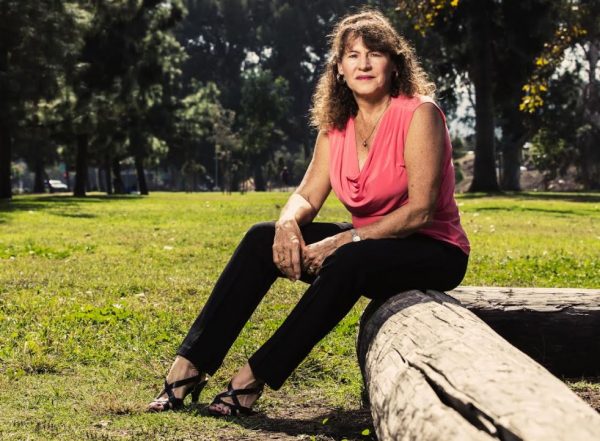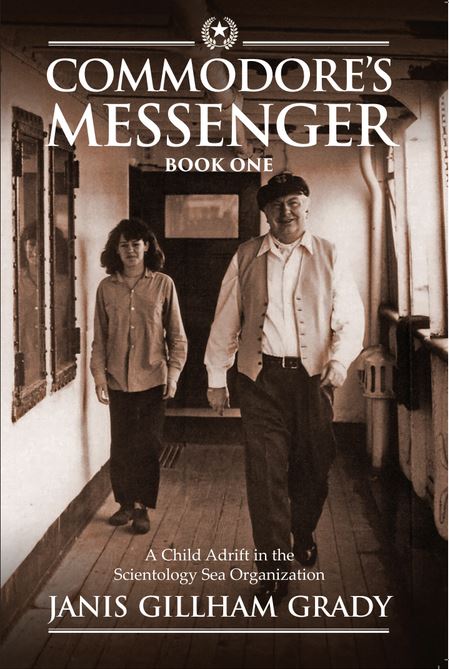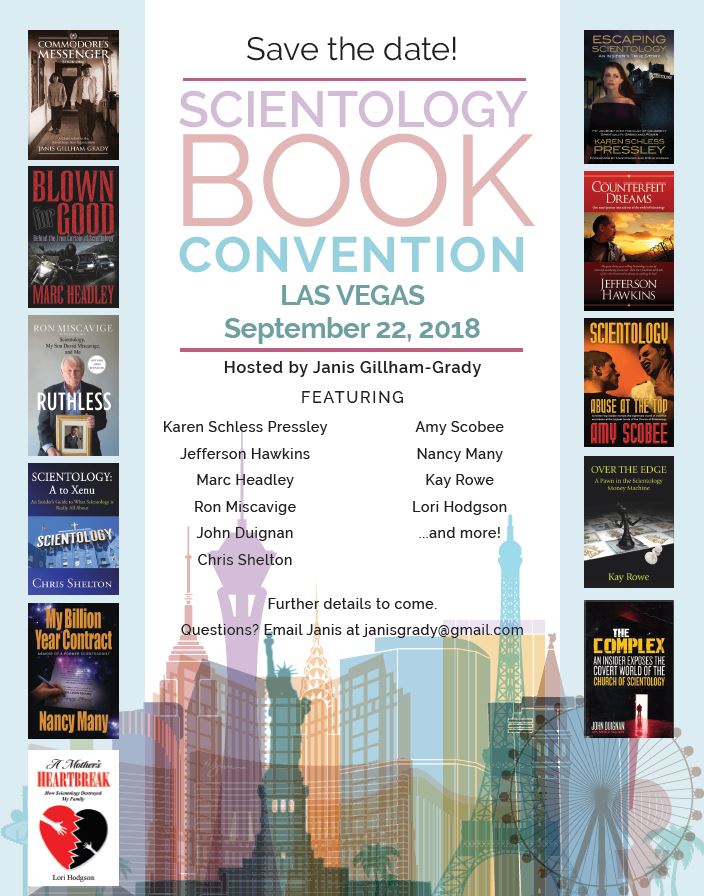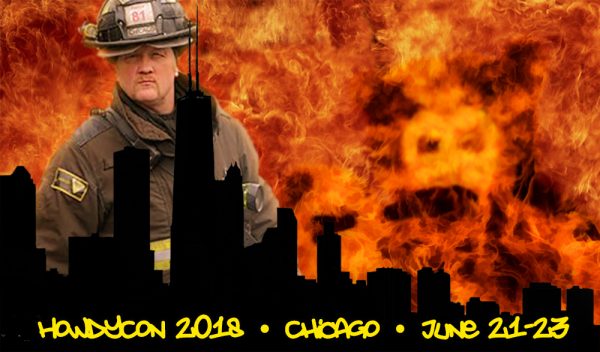This week we’re continuing our series of excerpts from books about Scientology with the entire opening chapter of Janis Gillham Grady’s Commodore’s Messenger: A diary of my life with L. Ron Hubbard in Scientology’s Sea Organization. Our thanks to Janis for such an extended look at her book, which follows her harrowing journey as a child in Australia caught up as one of Hubbard’s personal indentured servants!
“STOP!” LAZ COMMANDED, as he grabbed me by the arm.
I shook him off as I ignored his command and kept walking. Laz jumped in front of me and grabbed both my arms to stop me from walking away.
“Get your filthy hands off me!” I shouted back, confronting him directly. Laz refused to let me go.
I shook his hands off me, then slapped him across the face and kept walking. Laz told the guard he had guarding me “Go get six of the biggest men that you can find.” Ignoring them, I made it halfway down the dirt road until the six men surrounded me. I was not allowed to move. Laz ordered them to block me from going anywhere for nearly fifteen minutes while he disappeared.
It didn’t matter if I yelled and screamed. We were in the middle of nowhere in the desert — I knew there was no one around to hear me! There was nowhere for me to run. Maybe the men expected me to kick and scream. I did not.
My intention was to defy them, I felt calm, considering the madness surrounding me. After a lifetime of growing up in Scientology, at age 22, I wanted to leave the Sea Org, the highest echelon of Scientology. I did not want to give up Scientology, as it was a way of life for me and I didn’t know much else. I just refused to be a slave anymore and didn’t agree with how staff members who worked within the rank and file of Scientology’s Sea Organization were being treated, including me.
When Laz returned, he ordered the six men to escort me to the back of the Ranch House. I could cooperate, or I could resist by screaming or trying to break free from their control — but what good would that have done? There was nowhere to go and no one around to help. I walked with them toward the usual entrance to the staff lounge and assumed I would be waiting there to see Maria Starkey in her office next door. But once I stepped inside, the door was closed behind me, and locked.
Laz had converted the hall of the Ranch House into a prison, with the doors to the rooms locked from the outside. Laz’s plan all along was to move me into this trap. I was locked inside a hall with a bathroom and locked off from the rest of the house. This confined space held only a mattress on the floor with two sheets, a pillow, a towel and bar of soap, and the clothes on my back.
I might have been able to climb out of the bathroom window, but where would I go? And my pockets were empty – no money. My brother Peter and my sister Terri shared a car with me, but my keys had already been taken, and the distributor cap had been removed in case I knew how to hot-wire it, which I did not.
I was being held prisoner against my will.
The guards, however, all thought they were helping me by following L. Ron Hubbard’s instructions on dealing with someone having a psychotic break. “Isolate the person wholly with all attendants COMPLETELY muzzled (no speech)” L. Ron Hubbard. However, there is a difference between having a psychotic break and refusing to be unjustly sent to the Rehabilitation Project Force.
Guards stood watch outside the door of my confinement for twenty-four hours a day. They were instructed to not talk to me. They unlocked the door only three times a day to quickly slide in some food and vitamins. They gave me a few pieces of paper and a pen to write down anything I had to say. Besides repeating that I wanted to leave, I had nothing else to say.
My first day of imprisonment, I caught up on my sleep. Sleep was treated as a luxury in the Sea Org, versus a healthy necessity. Since I was a prisoner with no other options, I took advantage of having the privacy and time to luxuriate in a hot bath while I daydreamed of what life might be like in the outside world.
The second day, bored with nothing to do, I ripped my pieces of blank papers into small, same-size pieces and made myself a deck of 52 playing cards and played solitaire. At least once a day I was asked through the door if I wanted to write to the Case Supervisor (this is the person that oversees the Scientology counseling). I did not. Plus, I wasn’t going to let them know I had used the paper they had given me to play cards. My torn-up paper cards were the only thing I had of value.
No one entered my hallway prison until about six days later, when my breakfast was dropped off. The guard actually entered my prison, saying nothing to me, while he quickly looked around the hall and bathroom, then left.
With no people contact, no phone, no computer, there was nothing to do but think by myself. Here I was, held captive, having fallen from the very top to the absolute lowest in the hierarchy of the Scientology world. This was a long way from having been in the mecca of Scientology in England, and then at the top echelon of Scientology as one of L. Ron Hubbard’s personal messengers on the Apollo and other locations. All I could do now was meander through some of the details about how I landed in this locked room.
I was living in La Quinta, California, a small town about 130 miles east of Los Angeles, tucked behind the Santa Rosa Mountains. I had been there with a small group of Scientologists employed by the Church of Scientology. This group’s job was to surround and support L. Ron Hubbard (LRH), the founder of the Church of Scientology.
Included at this secretive location was a group of mostly young ladies, known as “the Commodore’s Messengers,” or just “the Messengers”. Within the Church of Scientology “the Messengers” were L. Ron Hubbard’s emissaries. As messengers, we stayed in LRH’s vicinity twenty-four hours a day to take dictation, run messages, ensure his household was smoothly run, filter all communications to him, and various other assigned duties. Some of LRH’s family and personal staff were also within this elite group at La Quinta.
In late 1976, LRH purchased three different properties attached to date tree fields. Palms was a Spanish style house with a swimming pool, tennis court and a date field on one side and behind it. Next to Palms was Olives that also had a swimming pool, date field, olive and citrus trees, along with four guest houses. On the back side of Olives was the Ranch House with a row of horse stables and a date packing plant, along with a date field and alfalfa field. We built a bunk house for men’s berthing next to the Ranch House. A short distance away on the other side of the alfalfa field was another property we referred to as Rifle, which consisted of a walled-in house with a pool and guest house, where LRH lived. There were stables at the front of the property used for storage of LRH’s personal belongings.
This group of properties were referred to as “WHQ” for Winter Headquarters, or “SU” for Special Unit, or “Over the Rainbow” — as the location of LRH was kept a secret from the rest of the world.
Besides these properties and a few other scattered houses was the La Quinta Resort and Club, consisting of a clubhouse, some houses and bungalows, a few swimming pools, some tennis courts and a horse riding stable for hotel guests. The rest of the town was mostly empty desert and date fields, and a Circle K mini-mart down the road (which today is a golf course). Roadrunners and rattlesnakes were our neighbors. Palm Desert was to the northwest of us.
In January of 1978, LRH launched his film-making project of training films for Scientologists. One day in early May, LRH with a shoot crew and messengers went to the Soboba Indian Reservation and Massacre Canyon Inn (MCI) in the San Jacinto area. When we arrived at the planned location, I saw the shoot was to take place in a thick brush setting in a gully. I put my purse with the keys to the car I was driving inside LRH’s motorhome for safekeeping. It was a twist of fate.
For the next part of the photo shoot, we packed up the equipment and prepared to move down the road about fifteen minutes to MCI golf course. We planned to break for lunch before shooting more film. Rising out of the gully, I headed towards LRH's motorhome — which was gone!
LRH’s chauffeur, Wik Allcock, had told LRH he would take the motorhome to the next location so it would be ready and waiting for him when he arrived for lunch. Normally, Wik would have told me, LRH’s messenger, but since I had been down in a gully, he went directly to LRH. Two other messengers and I had a car but no keys. I quickly arranged for each of us to catch rides with the film crew so we could be with LRH when he arrived at MCI. As soon as I got to the motorhome, I grabbed my purse with the car keys and hurriedly found someone to take me back to the stranded car.
When I finally got back to the group, lunch was over and the scene at the golf course was being set up for filming. LRH did not say a word to me as I jumped back in to help set up the shot, so I didn’t know he noticed I was missing for about half an hour.
Upon our return to the base in La Quinta, LRH sent a messenger to tell me I was in a “condition of liability” for negligence. LRH describes the condition of liability, as a person who has “ceased to be simply non-existent as a team member and has taken on the color of an enemy.” This ethics condition is normally assigned where careless or malicious and knowing damage is caused to projects, organizations or activities. I felt impotent to defend myself, since I did put the keys in the motorhome, but I was not about to disagree and get myself in further trouble. I hated being in trouble.
The next day, LRH ordered that I have a “List One Security Check”. This consisted of being interrogated using a list of questions monitored by an E-meter. In those days, the FDA required that the E-meter could only be referred to as a religious artifact, or they might confiscate it as an unapproved diagnostic tool. The E-meter is an instrument that measures mental resistance as shown in the meter’s needle reactions. It is used as a tool in Scientology auditing, or spiritual counseling, as well as in ethics interrogations as a “lie detector”, for what are called “security-checks”. A List One Security-Check was a serious form of interrogation, used to detect whether I had any evil intentions towards LRH, his wife Mary Sue, Scientology, or other aspects of Scientology. If the needle on the E-meter started slamming back and forth, it was called a “rock slam,” indicating evil intentions (according to Hubbard).
I could not believe that I was going to be subjected to a List One Security Check. After years of loyal and dedicated service to LRH, I was now being treated like an enemy! Especially at a time when I was still struggling with the loss of my mother, whose recent death left me filled with questions and regrets about the way she had been handled within Scientology. Dan Koon, who had been helping me address my emotions connected to this loss, reluctantly began the security check, knowing it was improper to change processes while leaving the traumatic loss incompletely addressed.
The security checking, I was receiving wasn’t helping my state of mind. Mid the sec-check, they changed the sec-checker on me. They reported the needle rock slammed while I was questioned about Mary Sue Hubbard, LRH’s wife. From this they concluded my error (putting car keys in the motor home) resulted from my evil intentions towards Mary Sue. I could not help but reflect that out of all the LRH messengers, I had the best relationship with her.
This whole mess had grown into multiple layers of problems. I had unanswered questions on the circumstances surrounding my mother’s death at the young age of 50, just three months prior, and having been lied to about it.
Mum had been a shining star in Scientology, the founder and leader of the Celebrity Centre in Los Angeles, and she was famously known as the epitome of a Scientologist. Any Scientologist who knew Yvonne knew of her exceptional ability to make things happen, and the way she related to people and handled herself in general. She was the Mother Theresa of Scientology and was known to deal with everyone with complete love and compassion.
When Mum became deathly ill in Los Angeles, no one informed me. My boss, Annie Tidman, along with a couple others, did know Yvonne’s medical issues, but decided it was best I didn’t know. When I received a letter from Mum, with incomplete sentences, I started asking every person that arrived at WHQ from Los Angeles if they had seen Yvonne and if she was OK. No one seemed to have seen her and assumed she was working long hours and very tired when she wrote the letter. Little did I know, they were lying. Meanwhile she was, in fact, dying.
By this time, I had not seen my mother in nearly a year. We had both agreed to take a week off to spend the time together once she returned from a tour of Mexico. When I submitted for my leave of absence to spend the time with her, it was denied. I was told Yvonne was not feeling well and needed to rest, so she could not take the trip. Plus, I was needed to help prepare for the return of LRH to the La Quinta property.
Annie Tidman, having returned from a trip to Los Angeles, told me she had checked on Mum and said it would be best that I wait to see her after she recovered from her illness. Plans had been made for Yvonne to go to Clearwater, Florida, where she would get better care. It was basically a lie. Everyone minimized the severity of Yvonne’s illness. I was repeatedly told not to worry.
Yvonne would be back soon and I could spend time with her. Meanwhile, my brother knew nothing of her illness at all, or that she had even gone to Clearwater.
Tragically, upon Mum’s arrival in Clearwater, she was sequestered to a room with few to no visitors. She could no longer work, so was considered a malingerer and someone not pulling their weight. Only my stepfather Heber Jentzsch, my father Peter Gillham (Snr), and my sister Terri Gamboa (who had to sneak away to Florida from California to see her), were able to say good bye. My mother died before my brother and I saw her again. Her illness, as well as her ultimate death, was considered “bad PR” for Scientology.
I could not shake the feeling of betrayal. The lies about her condition, the cover-ups of facts, and how others prevented me from knowing what really happened, just held my grief in place. I sat in the middle of this for months, before this car key incident happened that led to my security check.
This was followed by my imprisonment by the very group that had betrayed me. It was mid-1978 and plenty of other Sea Org members around this time period, no matter how well they were doing on their posts, were automatically assigned to the Rehabilitation Project Force (RPF) if they rock slammed during the List One Security Check. The RPF filled up fast with good staff members, due to an all-out witch-hunt, and I was to join them. The RPF was established as a place for Sea Org members to “rehabilitate” themselves so they could be better members of the group when done.
RPFers were assigned the dirtiest and grossest jobs of hard labor. They were required to run, not walk, everywhere, and were forbidden to speak to anyone not on the RPF. All people relegated to the RPF were required to live communally as a group in the garage of the Palms property. They were no longer allowed to live with their spouses. Personal time was gone, no time off, quarter pay only. And everyone not on the RPF had to be addressed as “Sir”. RPF food consisted of leftovers from the other crew. This “rehabilitation” program at the Scientology penal colony stripped staff members of all rights and dignity.
Anyone assigned to the RPF became the automatic responsibility of the RPF unit only, since no one else at the base wanted to deal with them. It was like having leprosy. If someone refused to go, as I did, anything you owned such as clothing and bedding got packed up and moved into the RPF space without your permission. At meal times, the galley only gave you food when the RPFers were being fed. The only people willing to talk to you, or people you could get help from, were other RPFers.
Before Laz trapped me, two RPFers were sent to escort me to the RPF. What little personal belongings I owned were packed by another into my suitcase and delivered to the RPF. The people I considered my friends no longer talked to me, and instead, turned their heads or changed directions, when they saw me. I had no way of knowing until much later, that when a fellow messenger or Special Unit staff member asked about me, they were told I had a “psychotic break”, so they didn’t attempt to intervene! It was standard practice in Scientology to lock someone up if they had a “breakdown,” and it was left up to Ethics and an auditor to handle. Many did not even know I was locked up, assuming I accepted going to the RPF. I had not had a breakdown, instead I refused to cooperate and follow orders.
The stigma from this RPF assignment brought me total betrayal. I felt completely alone, fully reliant on myself to protect or defend my rights. I wondered if LRH would notice I was missing and send a messenger to order my release after realizing a mistake had been made. Having grown up since age 11 without my father around but having worked for LRH nearly every day for 10 years, LRH had been like a father to me. So much betrayal!
Laz couldn’t convince me to do the RPF. There was nothing about the program — not the studying or the auditing for five hours a day, or the hard labor for the rest of the day — that addressed the circumstances of my life. Laz continued to use various tactics to refute my rejection of his explanations and pleas. He tried to praise me for my years of success as a senior messenger. He resorted to complimenting my legs, and telling me that if I stuck with him, life would be much more comfortable in the RPF. He could ensure I got the easier jobs, but if I continued to refuse the program, he could make my life miserable. Eventually, Laz said the RPF didn’t want me to be part of their group, and that I was assigned to the RPF’s RPF, the lowest of the low elements of the RPF prison population. These people could not talk to anyone, including other RPFers, could not make eye contact with anyone, and had as much status in life as the dirt on the bottom of my shoe.
I held my ground. No RPF or RPF’s RPF for me.
Laz placed me under guard by male RPF members, to prevent me from leaving and tried to get me to join the rest of the group doing hard labor. By this point, not even the RPFers, nor the staff who ran the RPF program, knew what to do with me.
Laz wanted to prevent me from further upsetting or influencing the rest of the RPFers who accepted their fate and were doing the program. He ordered the guard to physically escort me to the driveway leading to the garage in which the RPF staff lived. The driveway was about eighty feet long and ran between Palms and a date tree field.
I spent two days under guard, while sitting in or walking up and down that driveway. I refused to enter the RPF’s garage area, where the RPF staff slept and studied in cramped, smelly spaces. A curtain separated the men’s sleeping quarters from the women’s, and the bunks were three high. I chose to spend two nights sleeping outside in the driveway under the stars and watchful eye of a guard. The guards worried I might bolt, so they walked behind me whenever I walked up and down the driveway. They were under strict instructions not to talk to me. But Steve, a guard married to one of my fellow messengers, talked to me out of earshot of the others. The rest of the guards refused to answer anything I might say to them. I started to have some fun by breaking into a run, then laughing at the guards when they panicked for fear I would keep running and not come back.
During those two days, several friends already on the RPF got permission to try to convince me to stay and do the RPF. No matter what anyone said, I knew I was not a bad person, and was determined not to do the RPF, and that I would rather leave and try to make my way in the outside world. This was in spite of the fact that I had worked full time for Scientology since I was 11 years old, and I had no experience outside Scientology.
Laz tried several more times, as did others, to try to convince me to stay. Laz turned to insulting me, saying I had been spoiled over the years and it was time to get off my high horse as I no longer had any status and was really a nobody. They continued to attack me personally for not accepting my fate as a person who needed Scientology’s rehabilitation, insisting I was acting like a stuck-up LRH messenger. They also pointed out that the RPF motto was “The RPF is what we make it,” so we could make it better than what people thought it was.
In my eyes, people who did the RPF were basically slaves with no determination of their own, and basically no freedom to think nor act for themselves.
— Janis Gillham Grady
Janis is organizing a convention for authors of books about Scientology this September in Las Vegas, when Janis will be releasing the second volume of her books. The list of writers is really terrific…
——————–
Make your plans now!
HOWDYCON UPDATE
Hey, we’re just a few weeks away from this year’s HowdyCon in Chicago, June 21-23. As in past years, we’re looking forward to meeting readers of the Bunker, culminating in Saturday night’s main event.
The biggest difference this year is that our Saturday night event is separate from that evening’s dinner. Chee Chalker is setting up an inexpensive pizza dinner that you don’t need to pay for ahead of time, after which we’ll walk over to the theater where our event, hosted by Chicago Fire star Christian Stolte, will take place. Because it’s a separate event, we’re asking that you pay $10 each to get into the Saturday night event, which will help us recoup what the Bunker paid for the venue. (We have never made a penny on our HowdyCon meetups, we only try to break even.)
Please email your proprietor (tonyo94 AT gmail) in order to reserve your spot for Saturday night’s main event. Seating is limited, and we’re going to have some really interesting people on stage and they may make a few announcements that you don’t want to miss.
——————–
Bernie Headley has not seen his daughter Stephanie in 5,133 days.
Katrina Reyes has not seen her mother Yelena in 1,736 days
Brian Sheen has not seen his grandson Leo in 279 days.
Geoff Levin has not seen his son Collin and daughter Savannah in 167 days.
Clarissa Adams has not seen her parents Walter and Irmin Huber in 1,342 days.
Carol Nyburg has not seen her daughter Nancy in 2,116 days.
Jamie Sorrentini Lugli has not seen her father Irving in 2,890 days.
Quailynn McDaniel has not seen her brother Sean in 2,236 days.
Dylan Gill has not seen his father Russell in 10,802 days.
Mirriam Francis has not seen her brother Ben in 2,470 days.
Claudio and Renata Lugli have not seen their son Flavio in 2,730 days.
Sara Goldberg has not seen her daughter Ashley in 1,770 days.
Lori Hodgson has not seen her son Jeremy and daughter Jessica in 1,482 days.
Marie Bilheimer has not seen her mother June in 1,008 days.
Joe Reaiche has not seen his daughter Alanna Masterson in 5,097 days
Derek Bloch has not seen his father Darren in 2,237 days.
Cindy Plahuta has not seen her daughter Kara in 2,557 days.
Claire Headley has not seen her mother Gen in 2,532 days.
Ramana Dienes-Browning has not seen her mother Jancis in 888 days.
Mike Rinder has not seen his son Benjamin and daughter Taryn in 5,190 days.
Brian Sheen has not seen his daughter Spring in 1,296 days.
Skip Young has not seen his daughters Megan and Alexis in 1,699 days.
Mary Kahn has not seen her son Sammy in 1,571 days.
Lois Reisdorf has not seen her son Craig in 1,153 days.
Phil and Willie Jones have not seen their son Mike and daughter Emily in 1,658 days.
Mary Jane Sterne has not seen her daughter Samantha in 1,902 days.
Kate Bornstein has not seen her daughter Jessica in 13,011 days.
——————–
 Posted by Tony Ortega on June 2, 2018 at 07:00
Posted by Tony Ortega on June 2, 2018 at 07:00
E-mail tips and story ideas to tonyo94 AT gmail DOT com or follow us on Twitter. We post behind-the-scenes updates at our Facebook author page. After every new story we send out an alert to our e-mail list and our FB page.
Our book, The Unbreakable Miss Lovely: How the Church of Scientology tried to destroy Paulette Cooper, is on sale at Amazon in paperback, Kindle, and audiobook versions. We’ve posted photographs of Paulette and scenes from her life at a separate location. Reader Sookie put together a complete index. More information can also be found at the book’s dedicated page.
The Best of the Underground Bunker, 1995-2017 Just starting out here? We’ve picked out the most important stories we’ve covered here at the Undergound Bunker (2012-2017), The Village Voice (2008-2012), New Times Los Angeles (1999-2002) and the Phoenix New Times (1995-1999)
Learn about Scientology with our numerous series with experts…
BLOGGING DIANETICS: We read Scientology’s founding text cover to cover with the help of L.A. attorney and former church member Vance Woodward
UP THE BRIDGE: Claire Headley and Bruce Hines train us as Scientologists
GETTING OUR ETHICS IN: Jefferson Hawkins explains Scientology’s system of justice
SCIENTOLOGY MYTHBUSTING: Historian Jon Atack discusses key Scientology concepts
Other links: Shelly Miscavige, ten years gone | The Lisa McPherson story told in real time | The Cathriona White stories | The Leah Remini ‘Knowledge Reports’ | Hear audio of a Scientology excommunication | Scientology’s little day care of horrors | Whatever happened to Steve Fishman? | Felony charges for Scientology’s drug rehab scam | Why Scientology digs bomb-proof vaults in the desert | PZ Myers reads L. Ron Hubbard’s “A History of Man” | Scientology’s Master Spies | The mystery of the richest Scientologist and his wayward sons | Scientology’s shocking mistreatment of the mentally ill | The Underground Bunker’s Official Theme Song | The Underground Bunker FAQ
Our non-Scientology stories: Robert Burnham Jr., the man who inscribed the universe | Notorious alt-right inspiration Kevin MacDonald and his theories about Jewish DNA | The selling of the “Phoenix Lights” | Astronomer Harlow Shapley‘s FBI file | Sex, spies, and local TV news










